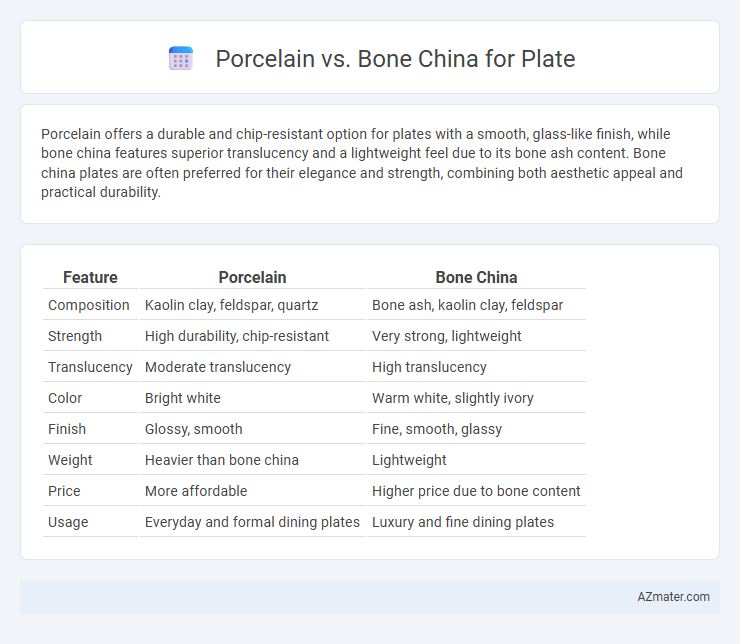Porcelain offers a durable and chip-resistant option for plates with a smooth, glass-like finish, while bone china features superior translucency and a lightweight feel due to its bone ash content. Bone china plates are often preferred for their elegance and strength, combining both aesthetic appeal and practical durability.
Table of Comparison
| Feature | Porcelain | Bone China |
|---|---|---|
| Composition | Kaolin clay, feldspar, quartz | Bone ash, kaolin clay, feldspar |
| Strength | High durability, chip-resistant | Very strong, lightweight |
| Translucency | Moderate translucency | High translucency |
| Color | Bright white | Warm white, slightly ivory |
| Finish | Glossy, smooth | Fine, smooth, glassy |
| Weight | Heavier than bone china | Lightweight |
| Price | More affordable | Higher price due to bone content |
| Usage | Everyday and formal dining plates | Luxury and fine dining plates |
Introduction: Porcelain vs Bone China Plates
Porcelain plates are made from a mixture of kaolin clay, feldspar, and quartz, resulting in a strong, durable material with a translucent quality. Bone china plates contain bone ash, which enhances whiteness, translucency, and chip resistance, making them more delicate yet resilient compared to traditional porcelain. Both materials offer elegant aesthetics and durability, but bone china is typically lighter and more expensive due to its refined composition.
Material Composition Differences
Porcelain plates are primarily made from kaolin clay, feldspar, and quartz, fired at high temperatures to create a dense, durable material with a translucent quality. Bone china incorporates bone ash, usually from cattle bones, mixed with kaolin and feldspar, resulting in a lighter, more chip-resistant, and whiter finished plate. The addition of bone ash in bone china increases its strength and translucency, distinguishing it from traditional porcelain in both texture and durability.
Manufacturing Processes Compared
Porcelain plates are made from a mixture of kaolin, feldspar, and quartz fired at high temperatures typically between 1,200degC and 1,400degC, resulting in a dense, hard, and non-porous surface. Bone china incorporates bone ash into the composition, alongside kaolin and feldspar, and is fired at slightly lower temperatures, around 1,200degC, producing a thinner, more translucent, and stronger material due to the calcium phosphate content. The manufacturing process of bone china requires precise control of the bone ash content and firing conditions to achieve its characteristic durability and whiteness compared to the more rigid and opaque structure of traditional porcelain.
Appearance and Aesthetic Qualities
Porcelain plates exhibit a smooth, glass-like surface with a translucent white finish that highlights intricate patterns and vibrant colors, offering a sleek and modern aesthetic. Bone china plates, known for their warm ivory hue and delicate translucency, provide a luxurious feel with a softer glow that enhances floral and traditional designs. The lightweight yet strong composition of bone china gives it an elegant, refined appearance compared to the more robust and crisp look of porcelain.
Durability and Everyday Use
Porcelain plates offer high durability with a dense, non-porous surface that resists chipping and withstands daily use and temperature changes effectively. Bone china plates, while known for their lightweight elegance and translucency, are slightly less durable but still suitable for everyday use due to their strength from bone ash content. Both materials are dishwasher safe and resistant to cracking, but porcelain generally provides better long-term resilience for frequent handling.
Weight and Handling Experience
Porcelain plates are generally heavier and offer a sturdier feel, making them ideal for everyday use and durability. Bone china plates are lighter with a delicate, translucent quality that enhances the handling experience, often preferred for formal dining. The lighter weight of bone china reduces hand fatigue during prolonged use, while porcelain provides a more substantial grip.
Heat Retention and Microwave Safety
Bone china plates exhibit superior heat retention due to their dense composition, maintaining food warmth longer than porcelain plates. Porcelain plates, while durable and often microwave-safe, can sometimes contain metallic elements or glazes that reduce microwave safety. Bone china generally offers better microwave safety, as its composition withstands rapid temperature changes without cracking.
Cost and Price Comparison
Porcelain plates generally cost less than bone china due to differences in raw materials, with porcelain made from kaolin clay and bone china incorporating bone ash for added strength and translucency. Bone china plates are priced higher because of their refined composition and delicate aesthetic appeal, making them a premium choice for fine dining. Consumers seeking budget-friendly options often prefer porcelain, while those prioritizing luxury and durability opt for bone china despite the premium cost.
Maintenance and Care Tips
Porcelain plates require gentle handling and should be washed with mild detergents to avoid surface scratches and maintain their glossy finish. Bone china plates, enriched with bone ash, are more durable but still need to be hand-washed with non-abrasive sponges to preserve their delicate translucency and prevent chipping. Both materials benefit from avoiding extreme temperature changes and being stored separately to prevent damage during stacking.
Which Plate Type Is Best for You?
Porcelain plates offer excellent durability and scratch resistance, making them ideal for everyday use and busy households. Bone china plates provide a lighter, more elegant appearance with superior translucency and chip resistance, perfect for formal dining or special occasions. Choosing the best plate type depends on your preference for strength and practicality versus fine aesthetics and refined presentation.

Infographic: Porcelain vs Bone china for Plate
 azmater.com
azmater.com